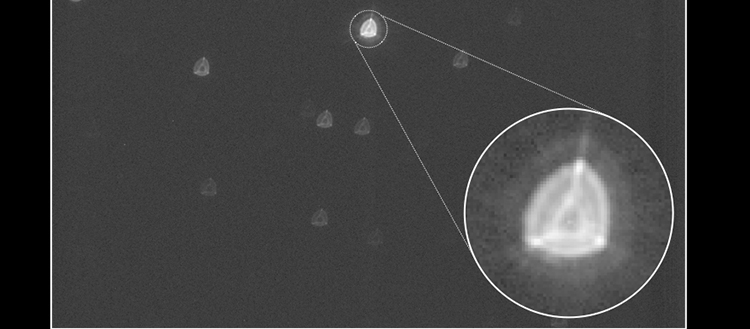CHEOPS space telescope takes its first pictures
CHEOPS has taken its first pictures. They are exceeding the expectations of the researchers.

First image of the star chosen as target for CHEOPS after cover opening. The star at the center of the image is located at 150 light- years from us in the constellation Cancer. The image is about 1000x1000 pixels with one pixel representing a tiny angle of about 0.0003 degree (1 arcsecond) on the sky. The other, fainter stars in the image are in the background of the central target. The inset in the lower right corner shows a region of about 100-pixel width centered on the target star. The peculiar shape of the star in the image is due to the on-purpose defocusing of CHEOPS optics. CHEOPS measures the star light by adding the light received in all pixels within a region illustrated by the circle. The defocusing spreads the light on many pixels, which allows CHEOPS to reach best possible photometric precision. © ESA/CHEOPS Mission Consortium/Airbus
Next milestone in the commissioning of CHEOPS: After the successful opening of the space telescope cover on January 29, 2020, CHEOPS has now taken its first images of the sky. CHEOPS is a joint mission of the European Space Agency (ESA) and Switzerland, led by the University of Bern, in collaboration with the University of Geneva.
The tension was high: In front of a large screen at the house near Madrid where members of the Consortium participating in the commissioning of the satellite live, as well as at the other institutes involved in CHEOPS, the team waited for the first images from the space telescope. "The first images that were about to appear on the screen were crucial for us to be able to determine if the telescope's optics had survived the rocket launch in good shape," explains Willy Benz, Professor of Astrophysics at the University of Bern and Principal Investigator of the CHEOPS mission. "When the first images of a field of stars appeared on the screen, it was immediately clear to everyone that we did indeed have a working telescope," says Benz happily. Now the remaining question is how well it is working.
First images even better than expected
Preliminary analysis has shown that the images from CHEOPS are even better than expected. However, better for CHEOPS does not mean sharper as the telescope has been deliberately defocused. This is because spreading the light over many pixels ensures that the spacecraft’s jitter and the pixel-to-pixel variations are smoothed out, allowing for better photometric precision. "The good news is that the actual blurred images received are smoother and more symmetrical than what we expected from measurements performed in the laboratory," says Benz. High precision is necessary for CHEOPS to observe small changes in the brightness of stars outside our solar system caused by the transit of an exoplanet in front of the star. Since these changes in brightness are proportional to the surface of the transit planet, CHEOPS will be able to measure the size of the planets. "These initial promising analyses are a great relief and also a boost for the team," continues Benz.
Further functional tests to follow
How well CHEOPS is working will be tested further over the next two months. "We will analyze many more images in detail to determine the exact level of accuracy that can be achieved by CHEOPS in the different aspects of the science program," says David Ehrenreich, CHEOPS project scientist at the University of Geneva. "The results so far bode well," said Ehrenreich.
7 Feb 2020